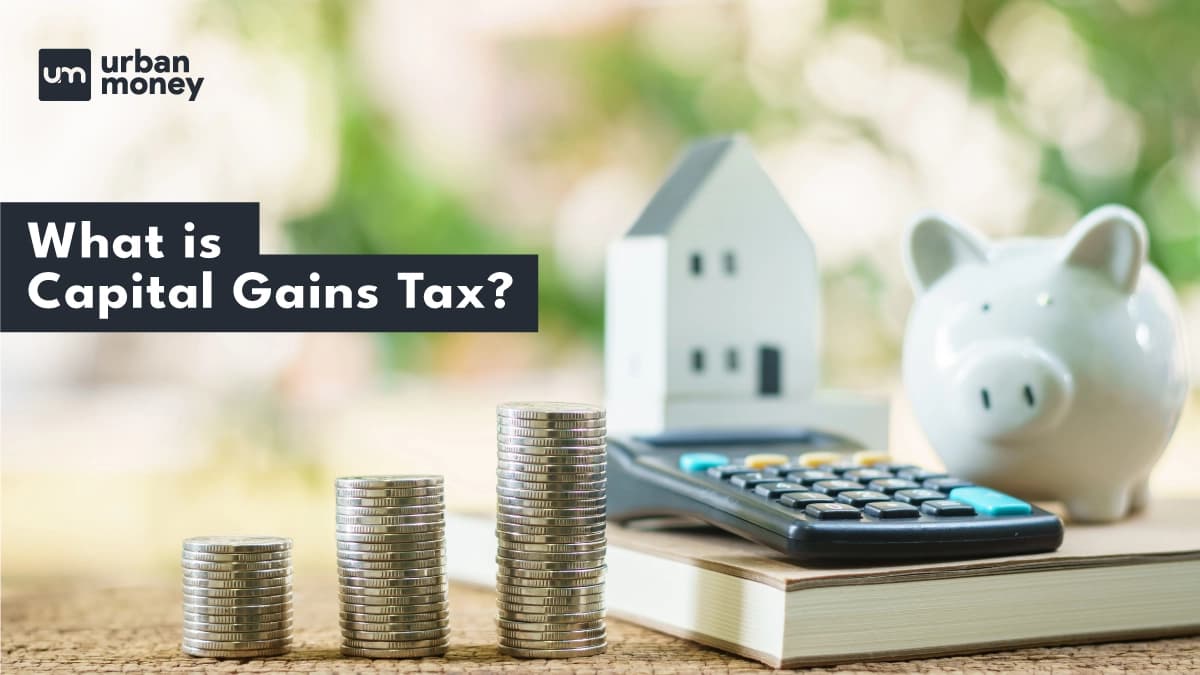- Home
- Income Tax
- Capital Gains Tax In India
Capital Gains Tax in India

- Personalized solutions
- Expert guidance
- Application assistance
- Credit score discussion
- Interest rate comparison


Last Updated: 4 January 2026
One of the most popular investments is buying real estate, mainly because you get to own a home. Others might make an investment with the goal of later reselling the property for a profit. It’s important to remember that, for income tax reasons, real estate is considered a capital asset. Hence, any profit or loss from the sale of real estate may be taxed under the title “Capital Gains”. Similar to this, sales of various kinds of capital assets may result in capital profits or losses. Here, we’ll go into greater detail on “What is Capital Gains Tax?”
Defining Capital Assets
Capital assets are defined as real estate, houses, buildings, cars, patents, jewellery, leasehold rights, and trademarks. This includes having ties with Indian businesses or owning stakes in them. It also includes any kind of legal right, such as those related to control or management.
Given below are the assets that do not fall under the capital assets category:
- Any inventory, raw materials, or supplies kept for use in a business or profession.
- Items of personal use, like furniture and clothing.
- India’s rural(*) agricultural land
- Central government-issued 612% gold bonds from 1977, 7% gold bonds from 1980, or National Defence gold bonds from 1980.
- Bonds with special bearers from 1991
- Gold deposit bonds or deposit certificates, which fall under the 2015 Gold Monetization Scheme or the 1999 Gold Deposit Scheme, respectively.
*Rural area definition (in effect from AY 2014–15) – A rural area is defined as any area with a population of 10,000 or more that is unincorporated and not under the control of a municipality or cantonment authority. Additionally, it should not be inside the range indicated below.
What are the Types of Capital Gains?
Capital assets include things like real estate, buildings, cars, machinery, jewellery, patents, trademarks, and more. The ownership rights to management or control over an Indian firm are also considered capital assets.
The two types of capital assets are as follows:
Short Term Capital Assets
A capital asset is considered short-term if it is retained for either 36 months or less than that.
Starting in FY 2023–24, the minimum is 24 months for immovable objects like land, structures, and homes. If you put up a residence for sale after 24 months of ownership, for example, any income will be regarded as a long-term capital gain until the sale takes place after March 31, 2023.
The 24-month term above does not apply to items that are movable, like debt-oriented mutual funds, jewellery, and other similar products.
- Investing in equity or preferred shares of a company that is listed on a reliable Indian stock exchange
- Bonds, debentures, and other securities listed on a reputable stock exchange in India include government securities.
- Whether or not quoted, UTI units
- Whether or not they are quoted, units of equity-oriented mutual funds.
- Regardless of whether they are quoted
Long Term Capital Assets
Assets that have been held for 36 months or more are considered long-term capital assets. They will be considered a long-term capital asset if kept for a duration longer than 36 months.
If the owner keeps an asset for a period of 24 months or more, such as a building or piece of real estate, it will be regarded as a long-term capital asset (as of FY 2017–18).
In contrast, the assets mentioned below that are held for a period of more than a year are deemed long-term capital assets.
- Equity or preferred shares in a business listed on a reputable Indian stock exchange
- Government securities, debentures, bonds, and other securities listed on an established stock exchange in India
- UTI units, whether or not quoted
- Equity-oriented mutual fund units, whether or not they are quoted.
- Whether or not they are quoted, zero coupon bonds
Calculation of Capital Gains Tax
complete value assessment of the sum of money the seller has received or will get in exchange for transferring his capital assets. Even if no consideration is received at the time of the transfer, capital gains are subject to tax in that year.
The cost of purchase is the price at which the seller purchased the capital asset.
Cost of the upgrade capital costs that the seller expended when making any upgrades or additions to the capital asset.
Point to Remember: The cost of acquisition and the cost of improvement incurred by the prior owner would also be included in certain situations where the capital asset enters the property of the taxpayer other than by an outright purchase by the taxpayer.
Before April 1, 2001, improvements were never taken into account.
How to Calculate Short-Term Capital Gains?
Given below are the steps that one can follow to calculate the short-term capital gains:
Step 1: Start by taking all factors into account.
Step 2: Subtract the following from the computation:
- Expenditure that was made solely and exclusively for this transfer
- Cost of purchase
- Cost of the upgrade
Step 3: After computing the above mentioned steps, you will get your short-term capital gains.
How to Calculate Long-Term Capital Gains?
Given below are the steps that one can follow to calculate long-term capital gains:
Step 1: Start by taking all factors into account.
Step 2: Subtract the following from the computation:
- Expenditure that was made solely and exclusively for this transfer
- Cost of purchase
- Cost of the upgrade
Step 3: After computing with the above mentioned steps and deducting sections 54, 54EC, 54F, and 54B, you will get your short-term capital gains.
Exemptions
According to the 2018 budget, up to Rs. 1 lakh per year, long-term capital gains on the sale of equity shares or units of equity oriented funds will remain free. In addition, tax at the rate of 10% will only be applied to long-term capital gains (LTCG) on shares or units of equity-oriented funds that exceed Rs 1 lakh in a fiscal year without the benefit of indexation.
Deductions
- House Property Sale
The following costs are subtracted from the final sale price:
- Commission or brokerage fees paid for finding a buyer
- The cost of stamps
- Travel costs associated with the transfer – these could be incurred after it has taken place
- Where property has been inherited, expenses incurred in connection with the will and inheritance, getting a succession certificate, and executor charges may occasionally be permitted.
- Selling of the Shares
You might be able to write off the following costs:
- Brokerage fees associated with shares sold
- Securities transaction tax (STT) cannot be deducted as a cost.
- The location of the jewellery sale: In cases where a broker’s services were used to find a buyer and jewellery was sold, the cost of the broker’s services may be deducted.
Point to Remember: Keep in mind that expenses subtracted from asset sale prices to determine capital gains are not allowed as deductions under any other category of income and can only be claimed once.
Indexed Cost of Acquisition/Improvement
Applying the cost inflation index, or CII, indexes the cost of purchase and improvement. It is carried out to account for inflation over the years the asset has been held. As a result, one’s cost base grows and capital profits decline.
The calculation of the indexed acquisition cost is as follows:
Indexed acquisition cost: The sum of the acquisition costs * the CII of the year the property was sold / the CII of the year the seller first purchased the property.
The calculation of the indexed improvement cost is as follows:
Cost Inflation Index (CII) for the year the property was sold * the costs associated with improvements / the CII for the year the improvements were made.
Capital Gains Tax Rates
Given below are the details of capital gains tax for your better understanding:
|
Type of Tax |
The Condition |
Tax Applicable |
|
Short Term Capital Gains Tax |
Selling of:
|
10% for 1 Lakhs or more |
|
Others |
20% |
|
|
Long Term Capital Gains Tax |
Non Applicability of Securities Transaction Tax |
Slab Rates (Normal) |
|
Applicability of Securities Transaction Tax |
15% |
Strategies for Minimising Capital Gains Tax
Capital gains tax can be minimised if computed strategically on property and on mutual funds as well.
Minimising Capital Gains Tax on Property
The taxpayer can either reinvest the revenues that came from the sale of the property in another real estate transaction or invest them in capital gains bonds issued by the National Highway Authority of India and the Rural Electrification Corporation in order to reduce capital gains tax on the property.
- Reinvest
Reinvesting all of the sale profits in another property within a specific time frame is one of the best ways to reduce the capital gains tax incurred when selling a property for a profit. Only a residential property, not a commercial property, may be used to reinvest the gains. When purchasing a new residential property, you have two years to complete the transaction. If you’re building a new property, you have three years. It’s crucial to remember that in this case, the new property should be a second residence other than the current one in order to avoid paying capital gains tax. If an individual already owns many properties, they cannot use this method to reduce their capital gains tax.
- Capital Gain Bonds
By investing the money received from the sale of the property in Capital Gains Bonds, one can also avoid paying capital gains tax. These bonds can currently only be issued by two government organisations: the Rural Electrification Corporation and the National Highway Authority of India. A person may invest a total of Rs. 50 lakh in these bonds. The promised interest rate, which is only 6%, is quite low, but since these bonds are backed by the government, there is virtually no risk that they would default.
- Reconstruction
By building another property with the money from the property’s sale, one can obtain a three-year extension.
Minimising Capital Gains Tax on Mutual Funds
There are two types of gains from mutual funds, short-term and long-term. Let’s learn how we can minimise the capital gains tax on both categories:
- Capital Gain Tax on Short –Term Gains
There is currently no way to lower the capital gains tax that is applied to your short-term profits for either equity or debt mutual funds. If you record short-term gains from debt funds, you must pay capital gains tax at your slab rate.
Similar to this, equity fund short-term gains are taxed as well. Therefore, you will be required to pay 15% Capital Gains Tax on your earnings if you redeem your equity investments before the first year has passed.
- Capital Gain Tax on Long –Term Gains
Your long-term capital gains are immediately eligible for the indexation advantage in the case of debt mutual funds. Your tax burden is automatically reduced as a result. Therefore, to qualify for the indexation advantage on redemptions, you just need to invest in a debt fund for three years or longer.
If you invest in equity mutual funds, long-term gains are only taxed if your income tax returns are greater than Rs. 1 lakh throughout the financial year. Therefore, you are exempt from paying capital gains tax on your returns if your long-term capital gains from equity mutual funds are less than or equal to Rs. 1 lakh in a financial year.
Conclusion
Earnings from the sale of assets like stocks or real estate are subject to taxes known as capital gains. The tax is calculated using the difference between the asset’s sale price and its acquisition price, and it is subject to various rates depending on the holding period and the taxpayer’s income level.
FAQ About Capital Gains Tax In India
What is Capital Gains Tax, and when is it applicable?
If an investment is kept for at least a year, capital gains taxes must be paid on the earnings from its sale. A Schedule D form contains the tax information. Depending on your taxable income for the year, the capital gains tax rate ranges from 0% to 15% to 20%.
How is Capital Gain calculated?
The entirety of your property’s adjusted cost base (ACB), as well as any costs and expenses you incurred to sell it, should be deducted from the proceeds of disposition to determine your capital gain or loss.
What is the difference between short-term and long-term capital gains?
Short-term capital gains are profits you generate from selling assets you’ve owned for less than a year. Long-term capital gains, on the other hand, are gains on assets you’ve owned for more than a year.
What are the exemptions available for Capital Gains Tax?
Certain categories of property are exempt from capital gains taxes. The sale of your primary house is the most typical capital gain exemption. Your primary abode, the residence of your spouse, ex-spouse, or kid, is referred to as your principal residence.
Can I deduct investment losses from my capital gains tax?
For the current tax year, you can use current capital losses to offset capital gains. Additionally, capital losses may be carried forward forever or back to three prior years. Investors may use it to reduce their tax obligations following a significant gain.
What is the capital gains tax rate, and how is it determined?
If an investment is kept for at least a year, capital gains taxes must be paid on the earnings from its sale. A Schedule D form contains the tax information. Depending on your taxable income for the year, the capital gains tax rate ranges from 0% to 15% to 20%. Rich people pay more.
